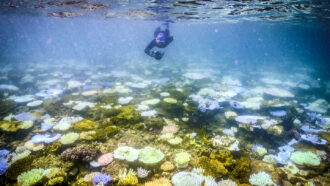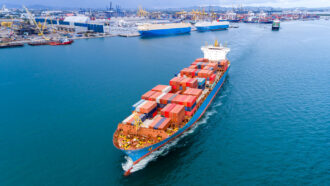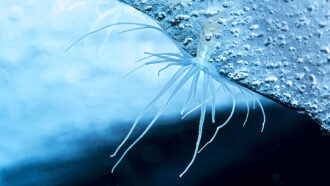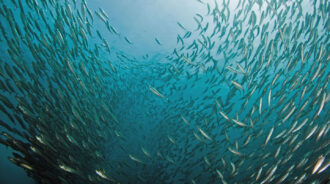Arctic ice travels fast, carrying pollution
As old ice melts, thinner sheets of fast-moving young ice transport pollutants and debris far and wide
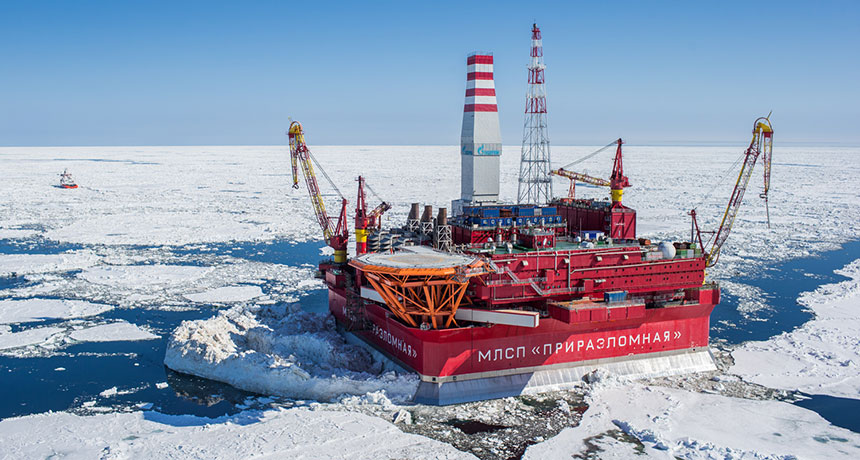
A warming climate may allow Arctic sea ice to move farther and faster than in the past. New research shows that the fast-migrating ice may carry debris and pollutants across the ocean, such as oil spilled by leaky drilling rigs.
Krichevsky/Wikimedia/(CC BY-SA 4.0)
SAN FRANCISCO, Calif. — Climate change could turn the Arctic Ocean into a high-speed ice superhighway. Chunks of sea ice in the Arctic are becoming thinner as old ice melts. The new ice that’s replacing it travels farther and faster than the older ice had. And as the younger ice travels, it carries dirt, organisms and pollution along for the ride, new research shows.
Researchers have been tracking the movements of Arctic ice for several years. They noticed that the area covered by ice making the trek from one side of the ocean to the other has grown larger and larger. That movement means that far-flung reaches of the Arctic are becoming more connected, notes Robert Newton. He’s an oceanographer at Columbia University’s Lamont-Doherty Earth Observatory in Palisades, N.Y. And he described his team’s new findings here, December 16, at the American Geophysical Union’s fall meeting.
The speedy ice is a problem, he explains. The reason: It boosts the risk of speading pollution from some environmental disaster, such as oil spills.
“You might imagine that the ice is this pristine environment,” he said. “But that’s not true.” He notes that “ice in the Arctic is surprisingly polluted. And when the ice travels from one part of the Arctic to the other, it carries all that material with it.”
Winds sweep airborne pollution north from lower latitudes. Much of that pollution can settle into the ocean and onto sea ice. Industries along Arctic coastlines, such as gold mining, oil drilling and copper refining, also can pollute the region’s waters. As new ice forms in the fall and winter, that pollution — along with nearby sand and other sediment — gets trapped inside the ice. When that ice then melts in the spring and summer, it will shed the pollution it carried back into the ocean.
Between when it forms and melts, the ice can get pushed across the Arctic by winds and ocean currents. These forces more easily shove young, thin ice along than old ice. Newton and colleagues wondered what the impact would be on these ice rafts and the pollution they held. Less ice could mean less space to carry a large load of pollutants and debris. But a less crowded Arctic might let the ice travel farther and faster.
To find out, the researchers put together snapshots of the Arctic. The pictures came from satellites far above the surface. They used computer software that can recognize the edges of sea ice. This allowed them to follow the movements of ice from formation to disintegration. To help them do that, they also included tracking buoys on the ice that had been outfitted with GPS devices.
Most Arctic ice does not go far, they found. About 60 percent of ice travels less than 100 kilometers (62 miles) from its birthplace. The rest covers an area equal to tens of thousands of square kilometers. It can travel hundreds or even thousands of kilometers. And the share of long-traveling ice is growing. Newton thinks the area of ice that travels a long distance over its lifetime is about 8 to 10 percent larger than it was even 15 years ago. That ice is moving faster, too: Ice now travels from Russia to Canada in four to five years or less. It took six to seven years to cover that distance only 15 years ago.
The new estimates may be low on the amount of wandering ice and the threat it poses, said Andy Mahoney. He works at the University of Alaska Fairbanks. As a sea-ice geophysicist, he studies how humans, oceans and sea ice affect one another. Fresh, fast-moving ice forms during October and November. But satellites struggle to capture that young ice. An oil spill during the summer could become trapped in this autumn ice. The oil could then quickly move from one country’s waters to another’s, he notes, rapidly spreading the spill’s impact on the environment.
Power Words
(for more about Power Words, click here)
Arctic A region that falls within the Arctic Circle. The edge of that circle is defined as the northernmost point at which the sun is visible on the northern winter solstice and the southernmost point at which the midnight sun can be seen on the northern summer solstice.
Arctic sea ice Ice that forms from seawater and that covers all or parts of the Arctic Ocean.
buoy A floating device anchored to the bottom of a body of water. A buoy may mark channels, warn of dangers or carry instruments to measure the environment.
climate change Long-term, significant change in the climate of Earth. It can happen naturally or in response to human activities, including the burning of fossil fuels and clearing of forests.
geophysics The branch of science that deals with the physical properties of the Earth, including its internal structure, magnetic and gravitational fields, climate, atmosphere, oceans, sea ice and land forms. People who work in this field are known as geophysicists.
GPS device Devices that calculate their position (in terms of latitude and longitude) from any place on the ground or in the air. They do this by comparing how long it takes signals from different satellites to reach them.
latitude The distance from the equator measured in degrees (up to 90).
oceanography The branch of science that deals with the physical and biological properties and phenomena of the oceans. People who work in this field are known as oceanographers.
organism Any living thing, from elephants and plants to bacteria and other types of single-celled life.
satellite A moon orbiting a planet or a vehicle or other manufactured object that orbits some celestial body in space.
sediment Material (such as stones and sand) deposited by water, wind or glaciers.




